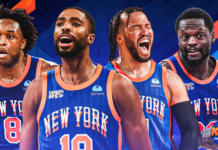The New York Knicks split a doubleheader series with the Cleveland Cavaliers. The Knicks continue their uneven play after five games.
Make sure to catch the whole Knicks Fan TV Postgame show on all major podcast platforms below:
• Spotify
• Apple Podcasts
• Google Podcasts
• Stitcher
The New York Knicks played an undermanned Cleveland Cavaliers in back-to-back games, winning the first match-up 109 to 91 but dropping the second game to Cleveland 89 to 95. The Knicks looked like two different teams in these games.
In game one, the Knicks overwhelmed Cleveland despite some moments of sloppy play. Jalen Brunson and Julius Randle looked closer to their forms from last season while the second unit hammered the Cavs’ third-stringers. It felt like Knicks’ basketball, more effective than pretty.
But any goodwill earned by the Knicks steamrolling their shorthanded opponent was lost in the rematch. New York shot the ball miserably: below 70 percent from the free throw line, 35 percent from the field, and less than 20 percent from the three-point line. The starters played without RJ Barrett, and no one stepped up in his absence.
This was New York’s second back-to-back in a row. But it’s tough to excuse their listless performances on night two, minus a handful of good performers. Let’s look at each player’s combined impact from both games.
New York’s starters show signs of hope in the first game, flop in the second
Jalen Brunson:
Game 1 – 19 PTS (7/16 FG, 1/3 3PT, 4/5 FT), 2 AST, 5 REB, 2 STL, 5 TO in 34 mins
Game 2 – 24 PTS (8/23 FG, 0/2 3PT, 8/9 FT), 4 AST, 4 REB, 1 TO in 39 mins
Jalen Brunson couldn’t recapture his dominance from last season, but he at least looks closer to that form. He played efficient scoring basketball in the first game, but 5 turnovers marred the performance. I wasn’t concerned about his two assist tally because Julius Randle handled the rock more than any game prior. Still, the turnovers are a strange problem this early in the year, mainly since New York’s starting line-up hasn’t changed.
Brunson tried to carry the Knicks’ struggling offense in game two. That led to some attrition, as he made barely a third of his attempts from the field. But New York’s leader got to the line, did some more playmaking, and limited his turnovers. The missing piece was Brunson’s ability to make those big, momentum-shifting baskets that helped so much last season.
Overall, Brunson was one of New York’s best players. But as his offense goes, so do the Knicks. Without much help from Randle and no RJ Barrett to lean on, Brunson couldn’t carry New York to a second win. He gets a 3 of 5 for trending in the right direction and taking 4 charges in game two.
Quentin Grimes:
Game 1 – 5 PTS (2/4 FG, 1/3 3PT), 1 AST, 1 REB, 2 STL in 22 mins
Game 2 – 5 PTS (2/7 FG, 1/6 3PT), 1 AST, 2 REB, 1 STL, 1 TO in 22 mins
I’m more disappointed in Quentin Grimes’ start to the season than any other player on the team. Despite all of the bluster about Grimes’ offseason and all of the promise he showed last season, Grimes looks hesitant at times and is lacking some elements of last year’s successful campaign. In these two games, he failed to convert open looks from the field and never asserted himself. His game-two invisibility was incredibly disheartening because RJ Barrett’s injury left an opening for Grimes to do more, but he didn’t step up.
But I have to give Grimes props for his defensive versatility. How many players can effectively go from guarding Jayson Tatum to Trae Young to Brandon Ingram to Donovan Mitchell? I could probably count them on one hand. Grimes offers New York flexibility as a defender that no one else can match.
The problem for Grimes is that simply being a good defender isn’t enough. IQ, DiVincenzo, and Hart can all play quality defense, too; but they add an element of scoring, passing, and rebounding that Grimes has yet to offer. Grimes gets a 1 of 5 for this letdown double-header, but I still have high hopes for the kid.
Game 1 – RJ Barrett: 16 PTS (5/13 FG, 3/5 3PT, 3/4 FT), 3 REB, 1 TO in 25 mins
Game 2 – DNP
RJ Barrett brought his hot streak into the first half of the game in Cleveland. But he barely touched the ball in the second half and forced the action when he did see the rock. That tanked his efficiency. Barrett’s tough fading performance may have been related to a sore knee that kept him out of the second game of the back-to-back.
Barrett’s game-one effort is worth 2.5 of 5 for half a very good performance.
Julius Randle:
Game 1 – 19 PTS (5/14 FG, 2/5 3PT, 7/10 FT), 2 AST, 10 REB, 1 STL, 1 TO in 31 mins
Game 2 – 6 PTS (3/15 FG, 0/6 3PT), 4 AST, 6 REB, 1 STL, 3 TO in 35 mins
Julius Randle turned in his most vintage performance of the season in the first match-up. Randle’s shot wasn’t falling, but he bullied his way into the post and created points off free throws and kickouts. It was a hopeful double-double for a struggling player that New York has relied on in the past.
The second game was problematic in several ways. Randle faced a soft defensive match-up in Georges Niang but failed to capitalize. He hesitated when he received passes off cuts and wound up in traps or getting blocked. His jumper is stuck in the Upside Down from Stranger Things. But even worse, Randle’s effort on the boards was weak, and he looked visibly frustrated in an exchange with Jalen Brunson.
The Knicks won’t go anywhere without Randle stepping up; they don’t even have a true backup power forward to replace him. Randle gets a 1 of 5 for his collapse in the second game of this series.
Mitchell Robinson:
Game 1 – 8 PTS (4/4 FG), 7 REB, 1 STL, 1 TO in 22 mins
Game 2 – 6 PTS (1/3 FG, 4/8 FT), 16 REB, 2 BLK, 1 TO in 32 mins
If not for Isaiah Hartenstein going off in game one, Mitchell Robinson probably would have had a double-double. He looked just as comfortable against the Cavs as he did in the playoffs. His numbers are only muted because he could rest more with his backup, handling a heavier load.
The fresh legs helped on night two, as Mitch gave New York 8 second chances and grabbed 16 rebounds. His only struggles came at the free-throw line. Robinson controlled the paint, as he’s known to do, giving the Knicks a fighting chance.
So far this season, Mitchell Robinson has been one of the Knicks’ best and most consistent players. He gets a 3.5 for a strong pair of performances.
The Knicks’ second unit provides some offense in both games
Immanuel Quickley:
Game 1 – 18 PTS (6/11 FG, 3/6 3PT, 3/3 FT), 2 AST, 3 REB, 3 TO in 24 mins
Game 2 – 18 PTS (7/16 FG, 0/3 3PT, 4/6 FT), 4 AST, 6 REB, 1 STL in 28 mins
Immanuel Quickley is my MVP of the series, at least for New York. His game-one numbers are slightly inflated because he went off in the fourth quarter. But the shots IQ made staved off a brief run by Cleveland. They might not have been necessary, but they earned the Knicks some extra rest.
Quickley was comfortably the best player on the Knicks in their second game. His three-ball wasn’t falling, but everything else worked. He’s settling into a nice rhythm, moving the ball with Donte DiVincenzo and Josh Hart. His defense is as good as last season or possibly better.
IQ gets a 4 of 5 for his pair of quality performances.
Donte DiVincenzo:
Game 1 – 3 PTS (1/3 FG, 1/3 3PT), 6 AST, 2 REB, 1 STL, 1 TO in 15 mins
Game 2 – 16 PTS (5/10 FG, 3/7 3PT, 3/5 FT), 2 REB, 2 STL, 1 BLK, 3 TO in 30 mins
Donte DiVincenzo looked the part of a playmaker in game one. He didn’t shoot much but turned several smart cuts into connecting passes that led to jumpers. His effort off the ball has the second unit moving like a well-oiled machine when they catch a defense off-balance.
DiVincenzo stepped up even more on night two. He was New York’s only reliable shooter from deep and finally finished some bunnies in the lane. On top of the offense, DD created some steals, blocked Caris Levert from behind, and continued to build on the second unit’s chemistry.
Josh Hart:
Game 1 – 6 PTS (2/6 FG, 1/3 3PT), 3 AST, 7 REB, 1 TO in 28 mins
Game 2 – 11 PTS (5/14 FG, 1/5 3PT), 3 AST, 8 REB, 2 TO in 29 mins
Josh Hart is getting closer to last season’s form, but a big piece of the puzzle is missing. Hart is grabbing boards and outracing opponents down the floor. He caught 15 boards and dished 6 assists in the two games combined. But he still looks hesitant to shoot and isn’t converting the shots he takes. He finished the series 7/20 from the field and just 2/8 from three.
Game two was incredibly disappointing since Hart replaced RJ Barrett in the starting unit. Without his jumper falling, Hart’s presence hurt New York’s spacing. The former Blazer still provided good defense, ball movement, and effort, but his fit with the starters won’t work when everyone shoots so poorly.
Hart gets a 2.5 of 5 despite the poor efficiency. His play is moving in the right direction, but he needs to find his confidence in the jumper.
Isaiah Hartenstein:
Game 1 – 13 PTS (5/10 FG, 0/2 3PT, 3/3 FT), 1 AST, 7 REB, 2 STL, 1 BLK, 1 TO in 23 mins
Game 2 – 0 PTS (0/2 FG), 2 AST, 6 REB, 3 STL, 2 TO in 16 mins
Isaiah Hartenstein put together a pair of productive games for the minutes he was given. He got extended time in game one and attacked Evan Mobley with a diverse array of approaches. I-Hart hit a spin move to a layup and even tried to take some long-range shots. His rebounding wasn’t Mitchell Robinson good, but it wasn’t far off.
In Game two we saw Big Hart play fewer minutes and fail to score. But he was still a good passer, rebounder, and defensive presence. With IQ and DiVincenzo scoring, I-Hart’s lack of points felt like less of a problem.
Hartenstein gets a 3.5 of 5, combining with Mitch for a pair of good performances from the bigs.
Miles McBride:
Game 1 – 3 PTS (1/2 FG, 1/2 3PT) in 4 mins
Game 2 – 3 PTS (1/2 FG, 0/1 3PT, 1/2 FT), 2 STL in 9 mins
Deuce McBride gets a shout-out for playing quality minutes off the bench in the second game of the back-to-back. He hit a three in mop-up duty for game one and turned a steal into a dunk in game two. His defensive pressure on Donovan Mitchell slowed the Cavs’ star down during a hot streak.
Tom Thibodeau’s got problems that are hard to fix
Tom Thibodeau can’t do much to change the Knicks’ fortunes while his top two players are this inefficient. He’d even have a hard time sitting Julius Randle for an extended period since Leon Rose gave Obi Toppin away without finding a replacement. When the team collectively shoots like a Stormtrooper, Thibodeau can’t save them.
But the Knicks’ coach isn’t excused from some head-scratching decisions. In the game one blowout, Cleveland’s starters left the game faster than the Knicks. Thibodeau left his guys out there despite coming off a back-to-back with another game a day later. That may be a contributing factor to their lack of legs in the second match-up.
Closing Thoughts
The smart thing to do right now is to remain calm. Look at some of the scores around the league in this early part of the season. Good teams have some ugly games, and a lot of strange things can happen. That’s why we never trust small sample sizes when tracking statistics.
But the Knicks were supposed to have a built-in advantage for the early part of the season. Continuity was going to keep them rolling while everyone else had to figure it out. That hasn’t been the case, and sloppy play is becoming worrisome. Julius Randle isn’t himself, Quentin Grimes is timid, and Jalen Brunson’s missing the edge that made him a star last year.
We still have to be patient. The schedule has been ridiculous, with consecutive back-to-backs against playoff-caliber opponents to start the year. The Knicks haven’t had a soft opponent yet, and this trial by fire should help when things lighten up. I’m not saying everything is great, but it’s way too early to turn negative.
The in-season tournament begins against the Bucks on Friday, and the KFTV crew will be at the Dean for a watch party. Hopefully, we bring good vibes, and the Knicks might start to find their way. I’ll see you then, Knicks fam!
Stay tuned to KnicksFanTV.com for the latest Knicks news, rumors, and recaps throughout the NBA season. And in case you missed it, check out CP’s interview with Steve Novak where they discuss the Knickstape Era!












